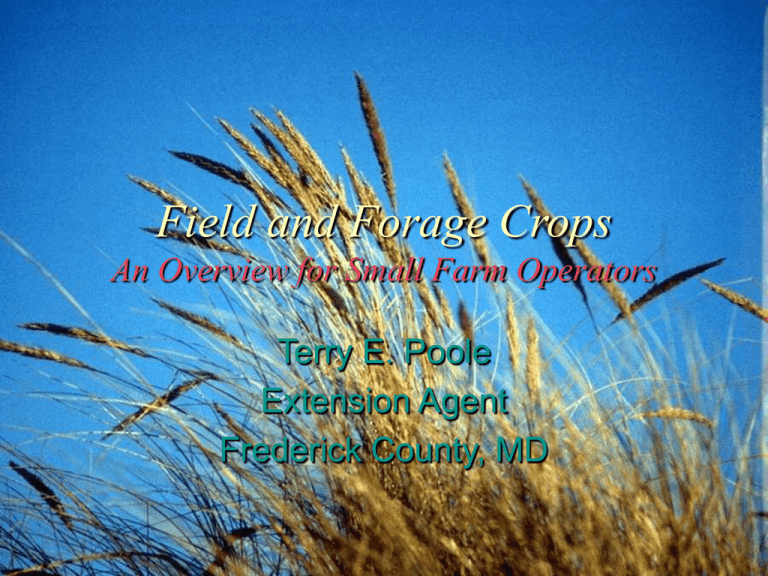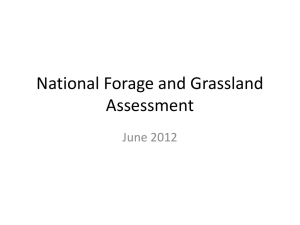Field and Forage Crops An Overview for Small Farm Operators
advertisement

Field and Forage Crops An Overview for Small Farm Operators Terry E. Poole Extension Agent Frederick County, MD What are field crops? • Crops grown for grain field corn soybeans wheat barley oats grain sorghum cereal rye Field crops harvested for grain often find their way into grain elevators for storage. What are forage crops? • Crops grown for animal feed. Alfalfa timothy field corn (silage) orchardgrass red clover kentucky bluegrass Forage crops are harvested directly for animal feed. Where do field and forage crops fit? • Both rely on machinery for production - except for pasture (grazing) • Field crops have high production costs and limited prices received - requires more than a few acres to be profitable • Forages are excellent conservation crops/cover crops Where do field and forage crops fit? • Field crops are very flexible. - grain (cash crop) - animal feed (forage) • Both forages and grains have established markets. • Both field and forage crops have established production technologies. Field Corn • Frederick County 2001 48,000 acres planted 23,500 acres harvested for grain 24,000 acres harvested for silage Avg. yield grain 90.1 bushels / A. Avg. yield silage 13.5 tons/ A. • Planting date varies (mid-April to mid-July) • Harvest date corn grain late Aug. to Nov. - early to late hybrid maturity • Average price received $2.19/bushel (56 lb) Wheat • Frederick County 2001 13,500 acres planted 12,000 acres harvested Average yield 65.4 bushels / A. • Planting date early Oct. to late Nov. • Harvest date late July • Variety maturity date can vary 2-3 wks. • Straw is a bonus crop $50 - $100 / ton • Average price received for grain $2.43 / bu. • Bushel weight 60 lb. Soybeans • Frederick County 2001 26,500 acres planted 25,900 acres harvested Average yield 35.4 bushels /A. • Planting date: - full season: May 15 to mid-June - double crop: late June to mid-July • Maturity date rated by groups III, IV, and V Group III (115-120 days) Group V (136148) • Average price received $4.09 / bushel (60 lb) Barley • Frederick County 2001 6,700 acres planted 5,500 acres harvested Average yield 71.7 bushels/ A. • Straw is a bonus crop. • Planting date mid-Sept. to mid-Oct. • Harvest date mid to late June • Maturity date can vary 2 weeks between varieties • Average price received $1.34 / bushel (48 lb) Oats • Frederick County 1997 1,400 acres planted 800 acres harvested Average yield 62.3 bushels/ A. • Straw is a bonus crop • Planting date mid-March to mid-April • Harvest date late July • Average price received $1.44/ bushel • Bushel weight 32 lb. Criteria for Selecting a Crop • • • • Is there a market for it? Can you use it? Are inputs too costly, limiting profit? Can you grow it; is there expertise available for technical support? • Can you get it harvested; timely? • Does it fit into your rotation? Be sure that when you select a crop that you can get it harvested. Field and forage crops can be very labor intensive to harvest. Field Crop Decision-Making • Do a budget first; include: land rental soil preparation seed seeding (if custom) fertilizer and pesticides harvesting and drying hauling (if custom) storage (if necessary) interest (on land) crop insurance Some Custom Farm Rates 2002 • • • • • • • • • • • • moldboard plow disk/heavy harrow / cultipacker cultipack corn/soybean planting convent. corn/soybean planting no-till drill small grain convent. no-till drill seeding combine grain mow spray apply fertilizer $16/ A $12 / A $12 / A $ 9/A $14 / A $15 / A $13 /A $15 / A $26 / A $11 / A $ 7/ A $ 7/A Take a look at some crop budgets at http://agguide.agronomy.psu.edu/PDF03/CM/ Sec11toc.html in the Penn State Agronomy Guide. You will see how tight it is to make a profit with field crops. What is forage? • Vegetable matter in a fresh, dried, or ensiled state. • What can you do with forage? - graze it - machine harvest and store it - it’s animal feed • Forage allows you to raise an agricultural crop on land where other crops cannot be produced. Forage Conditions • Fresh - pasture / grazing - greenchop (cut & carry) • Dry - hay (80 - 85% dry matter) • Ensiled - haylage (45 - 60% dry matter) - silage (35 - 40% dry matter) Silage and Haylage • Fermented feed (anaerobic process) - pH 3.8 to 5.0 • Storage facilities - upright silo - trench silo - ag bag - round bale stuffer - round bale wrapper - round bale bag Forage Species Selection • Match forage to your animal production needs. • Match forage to the style of operation. • Match forage to the soil type and soil conditions. • When possible, select improved varieties of forage species. • Getting off to a good start with a healthy thick stand eliminates early problems. Forage Species Menu • Legumes alfalfa red clover white clover hairy vetch ladino clover birdsfoot trefoil crownvetch lespedeza soybeans alsike clover Legume Inoculation • Legumes “fix” nitrogen (N) in a symbiotic relationship (root nodules) with Rhizobium sp. bacteria. • Infection takes place at seed germination so high populations of the proper bacterium are necessary for adequate nodulation. Root Nodules on Clover • This slide shows healthy, pink nodules on clover roots. • The nodules were formed when Rhizobium bacteria invaded the clover roots. Alfalfa Roots Healthy, pink nodule Healthy, functioning nodules are pink, while nonfunctioning are gray. Alfalfa Inoculation Study Good Inoculation No nodulation Here is a comparison of alfalfa plots seeded with and without proper inoculation. The green strips are alfalfa plants grown with proper seed inoculation. The yellow strips show severely nitrogen deficient alfalfa plants grown without proper seed inoculation. Proper Inoculation • Always inoculate legume seed, or use pre-inoculated seed. • Check expiration date on seed, or inoculant package. • Use correct inoculant specific to the legume you are inoculating. • Store inoculum and inoculated seed in a cool, dry place. Inoculum is a living organism. • Low pH and heavy N use reduce nodulation Forage Species Menu • Grasses timothy sudangrass orchardgrass sorghum kentucky bluegrass sudex tall fescue pearl millet perennial ryegrass field corn annual ryegrass reed canarygrass small grains (wheat, rye, barley, oats) Mixing Forage Species Consider the traits of each species. Aggressive vs. Passive Maturity dates: early vs. late Other traits that can be utilized: N fixation heat tolerance fast germination wet tolerance sod formation palatability summer dormancy hay, or grazing life span fertility needs Tillage and Seeding Methods • Conventional moldboard plow disk harrow cultipacker planter (drop, broadcast, drill, etc.) • Minimum till (30% or more residue) chisel plow disk planter (no till drill) • No till no till drill sprayer Forage Establishment • Plan at least 1-year ahead. • Planning includes soil testing. • Don’t be cheap with fertilizer, limestone, and seed. • Do proper field preparation. • Select the right forage species and best available varieties of that forage. • Need good seed/soil contact. • Don’t bury seed too deep. Forage Establishment • Pay attention to forage planting dates. - Spring (mid-March to early May) - Fall (mid-August to early Oct.) - Summer annuals, after May 15 - Winter annuals (Sept. to Nov.) • Monitor new stands for early trouble. Harvesting Forages • Stage of harvest is #1 quality factor. - boot stage for grasses - early bloom for legumes • Field losses during harvest is #2 factor - moisture is the enemy - hay is most at risk while drying in the field - drying stems is the toughest Harvesting Forage • Equipment is available to help speed up drying. - mower conditioners, tetters, rakes, row flippers - drying agents, or preservatives are available to be sprayed on hay to speed up drying, or prevent molding Harvesting Forages • Making quality forage is an art. - need to know your forage species - keep on top of the weather - have flexible production options - have timely access to equipment - have equipment in good working order - have healthy forage and few weeds - have some luck! Forage Storage Losses • Uncovered bales stored outside • Hay baled too wet • Bales stacked in contact with the ground • Holes in plastic bags and tubes, or leaky silos • Poorly packed and uncovered trenches The End






